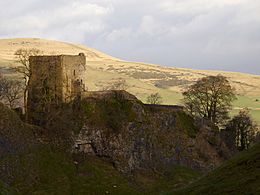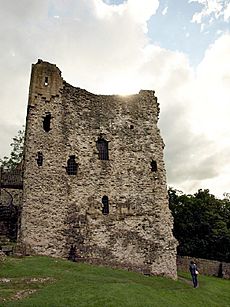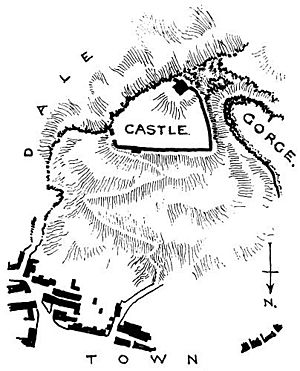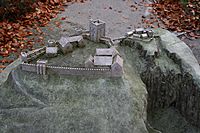Peveril Castle facts for kids
Quick facts for kids Peveril Castle |
|
|---|---|
| Castleton, Derbyshire | |

Peveril Castle from Cavedale with Lose Hill in the background
|
|
|
Location within Derbyshire
|
|
| Coordinates | 53°20′25″N 1°46′38″W / 53.3402°N 1.7772°W |
| Site information | |
| Owner | Duchy of Lancaster |
| Open to the public |
yes |
|
Listed Building – Grade I
|
|
| Official name: Peveril Castle, curtain walls and fragmentary foundations | |
| Designated: | 17 April 1985 |
| Reference #: | 1250966 |
| Official name: Peveril Castle eleventh to fourteenth century tower keep castle | |
| Designated: | 9 October 1981 |
| Reference #: | 1010829 |
| Condition | Ruins |
Peveril Castle is a ruined castle from the 11th century. It stands high above the village of Castleton in Derbyshire, England. It's also known as Castleton Castle or Peak Castle.
This castle was the main home of William Peverel, a powerful lord. He founded it sometime between the Norman Conquest in 1066 and 1086. The castle is mentioned in the Domesday Book of 1086. Peveril owned lands in Nottinghamshire and Derbyshire. Castleton became an important town for his lands. The castle offers amazing views of the Hope Valley and Cave Dale.
William Peveril's son, William Peveril the Younger, took over the estates. But in 1155, King Henry II took them for himself. King Henry II visited the castle several times. In 1157, he even hosted King Malcolm IV of Scotland there. During a rebellion in 1173–1174, the castle's guards were increased.
Later, the Earls of Derby tried to claim the Peveril family's lands. In 1199, William de Ferrers paid a large sum for the Peak lordship. But the castle stayed under royal control. In 1216, King John gave the castle to William de Ferrers. However, the castle's commander refused to give it up. The king allowed Ferrers to use force, and the commander eventually gave in. There's no sign the castle was actually attacked.
In 1223, the castle returned to the Crown. More building work happened in the 13th century. By 1300, the castle looked much as it does today. In the late 14th century, the castle was given to John of Gaunt. He didn't need the castle much, so he ordered parts of it to be removed and used elsewhere. This was the start of its decline.
Since John of Gaunt's time, the Duchy of Lancaster has owned and managed the castle. Peveril Castle became less important over time. By 1609, it was described as "very ruinous and serveth for no use." In the 19th century, Sir Walter Scott wrote about the castle in his novel Peveril of the Peak. Today, the castle is in a national park. It is cared for by English Heritage. Peveril Castle is a protected scheduled monument and a Grade I listed building.
Contents
History of Peveril Castle
Peveril Castle sits on a high limestone rock. It overlooks the west end of the Hope Valley. This area has a long history. Just 2 km west is Mam Tor, an old Bronze Age hill fort. About 2 miles east, at Brough-on-Noe, is the Roman fort of Navio. The valley was a natural route for travel. It was also important because of valuable lead in the area.
How Peveril Castle Began
The castle's founder, William Peverel, was a supporter of William the Conqueror. He was rewarded for helping in the Norman Conquest. In 1068, he was given the new castle at Nottingham. This happened while William the Conqueror was taking control of central and northern England. Some stories say Peveril was William the Conqueror's secret son, but this isn't proven.
By 1086, William Peveril was a very powerful landowner. He owned lands in Nottinghamshire and Derbyshire. We don't know the exact year he built Peveril Castle. But it must have been before 1086, as it's in the Domesday Book. It was one of only 48 castles mentioned and the only one in Derbyshire. Early Norman castles were often made of wood. But Peveril Castle seems to have been planned to be built from stone right from the start.
William Peveril also looked after royal lands, like the area of Hope. Even though he had his own lands, he needed the king's support to stay powerful. In 1100, King Henry I gave William control of "his demesne in the Peak." This made the Peak an independent lordship under William Peveril. The castle became a key place for managing the area and collecting taxes. Castleton grew as the main economic center of the lordship.
William Peveril died in 1114. His son, William Peveril the Younger, took over. During a civil war called The Anarchy, Peveril supported the losing side. He was captured at the Battle of Lincoln in 1141. In 1153, Peveril was suspected of trying to poison Ranulf de Gernon, 4th Earl of Chester. The future King Henry II accused Peveril of "plundering and treachery." He threatened to take Peveril's lands. Two years later, Henry, now king, did just that. The Earl of Chester had died, so the king kept the property for himself. Peveril Castle then became the main center for the Forest of High Peak.
Royal Control and Changes
William Peveril the Younger died in 1155. Since he had no living sons, his daughter, Margaret Peveril, tried to claim the lands. Her husband was Robert de Ferrers, 2nd Earl of Derby. King Henry II visited Peveril Castle three times. In 1157, he hosted King Malcolm IV of Scotland. Malcolm paid respect to Henry and gave up lands in Cumberland and Westmorland. Henry II visited again in 1158 and 1164.
In 1173–1174, some powerful lords, including Henry's own sons, rebelled against him. King Henry spent £116 on building work at Peveril and Bolsover Castles. The castle's guards were also increased. Before, Peveril had two watchmen and a porter. During the revolt, it had a force of 20 knights, shared with Bolsover and Nottingham castles. After the rebellion ended in 1174, more improvements were made. Records show £184 was spent between 1175 and 1177 to build the keep. Building with stone was very costly back then.
Henry II died in 1189, and his son Richard the Lionheart became king. Richard soon gave the Peak lordship, including the castle, to his brother John. While Richard was away on a crusade, John rebelled. When Richard returned, he took back the lordship. John became king in 1199 after Richard's death. William de Ferrers, 4th Earl of Derby still claimed the Peveril lands. He paid King John 2000 marks (about £1333) for the Peak lordship. But the Crown kept Peveril and Bolsover Castles.
In 1216, King John finally gave Ferrers these castles. He needed Ferrers' support during a country-wide rebellion. However, the castle's commander, Brian de Lisle, refused to hand them over. Even though both were King John's supporters, the king allowed Ferrers to use force.
Peveril Castle in the 13th Century
Things were still unsettled when King Henry III became king in 1216. Bolsover Castle fell to Ferrers' forces in 1217 after a siege. But there's no sign Peveril was attacked. It's likely Brian de Lisle gave up peacefully. Ferrers only held the lordship until King Henry III was old enough to rule. When that time came, Ferrers didn't want to give it back. But after some disagreement, the Crown took control in 1223.
Records of spending at Peveril exist, but they don't say exactly what the money was for. It's hard to tell what was just maintenance and what was major building work. However, some historians believe there were two periods of big building work. This was from 1204–1207 (£54 spent) and 1210–1212 (£67 spent). In 1200, only a few very rich lords in England earned more than £400 a year. A knight could live well on £10 to £20 a year.
The rest of the 13th century was mostly peaceful for the castle. Records show the Crown kept Peveril Castle in good repair. In 1235, the north wall and bridge were fixed for a royal visit. A lot of work was done in 1250–52 (£60), 1272–1275 (£40), and 1288–1290 (£151). It's likely the castle was finished by 1300.
King Henry gave Peveril Castle to his son, Prince Edward (who later became King Edward I). Some of the lands, including Peveril, were set aside for Eleanor of Castile. This meant she would get them if her husband, Prince Edward, died. At this time, the Peak lordship was worth about £300 a year.
During the Second Barons' War in 1264, Robert de Ferrers, 6th Earl of Derby took over Peveril Castle. Simon de Montfort pressured King Henry III to give him Peveril. But after De Montfort died in 1265, the Crown got it back. The castle was returned to Eleanor. Since she died before her husband, the lordship went back to the king. Its income helped support royal family members, like King Edward II's queen, Isabella of France. In 1331, King Edward III gave the lordship to his wife, Philippa of Hainault. It was later given to John de Warenne, 7th Earl of Surrey, in 1345. After returning to the Crown, it was given to John of Gaunt.
The Castle's Decline
When John of Gaunt took ownership, Peveril Castle began to decline. He was the richest nobleman in England and owned many castles. Peveril Castle wasn't very important to him. So, he decided not to keep it up. In 1374, he ordered lead to be taken from the buildings. This lead was then used at Pontefract Castle.
His son, Henry Bolingbroke, who later became King Henry IV, inherited it. The castle remained under royal control, managed by the Duchy of Lancaster. During the 15th century, Peveril became less important. Its administrative jobs were moved elsewhere. Other castles managed by the Duchy of Lancaster were repaired in 1480, but Peveril was not. A survey in 1561 showed Peveril was falling apart. As a result, it was one of two castles that were abandoned. However, local courts were held at the castle until 1600. A survey in 1609 found Peveril was "very ruinous and serveth for no use." Over time, the outer stones were removed from three sides of the keep. The steep slope on the fourth side stopped them from taking stones there. At one point, the castle was even used to keep animals.
Peveril Castle Today
When railways arrived in the 19th century, the area became popular with tourists. The Duchy of Lancaster did some repairs in the 19th century. They mostly cleared rubble and added mortar to stop the castle from getting worse. Sir Walter Scott's 1823 novel Peveril of the Peak described the castle ruins.
In 1932, the Duchy gave the castle to the Office of Works to look after. The Duchy still owns it. Today, English Heritage cares for the site. The land around the castle has been a national park since 1951. The castle is a scheduled monument. This means it's a "nationally important" historic site that is protected. It's also a Grade I listed building (since 1985). This means it's considered an internationally important structure.
Peveril Castle has been called "perhaps the finest medieval landmark of the Peak District." One historian, Nikolaus Pevsner, said it is "By far the most important castle in the county – in fact the only one of importance." Before Duffield Castle was destroyed in 1266, it had one of the largest keeps in England. But only its foundations remain today.
What Peveril Castle Looks Like
Peveril Castle in Castleton is shaped roughly like a triangle. It's about 90 meters by 65 meters. It sits on top of a hill overlooking the Hope Valley. The land drops steeply away from the castle's edges. This creates an almost sheer cliff on the south-east side. The winding path from the north is the easiest way to reach the castle. The site was naturally easy to defend. Its high position also made the castle a clear symbol of the builder's power. The town of Castleton provided supplies for the castle. From the castle, you can see Hope Valley, Treak Cliff, Mam Tor, Black Tor, and Lose Hill.
You entered the castle through the gatehouse on the east side. Its design was simple, about 7 meters wide with a passage 2.5 meters across. Not much of it is left today. But older drawings show details that suggest it was built in the 12th century. Perhaps King Henry II or King John built it.
The curtain walls that surround the castle show different building stages. You can see stonework from the Norman period, which used a special pattern called opus spicatum. There are also modern repairs. Walkways ran along the top of the walls. Near the gatehouse, these walkways would have been about 5 meters above the ground outside the castle. In the 12th century, a small tower was added to the north wall. It stuck out less than 2 meters. Experts say it "would have been of limited military value." Later castles had towers that stuck out more. These allowed defenders to shoot along the base of the walls. The land inside the castle slopes down from west to east. Storing water was important for the castle's defenders. But we don't know exactly how they got their water.
The southern curtain wall is a modern replacement. But it follows the line of the old medieval wall. There are remains of two round or semi-circular towers sticking out from the wall. Enough of one tower remains to see that Roman tiles were used in its building. These probably came from the fort of Navio, 2 miles away. We don't know when these towers were built. But it's thought they might be from the 13th century.
Foundations show where buildings once stood against the south wall. These were probably the old hall and a chapel. A document from 1246 mentions a chapel at the castle. The remains of the easternmost building against the south wall are thought to be the chapel. This is because they face roughly east–west. Foundations at the west end of the north wall show a large building. This was probably a hall where the lord would eat and entertain important guests. We don't know when this new hall was built. It likely replaced the old hall in the south of the castle. A document from 1251 mentioned an "old hall," suggesting there was also a new hall by then. The kitchen and food stores would have been at the east end of the hall. But little remains of those structures. Buildings were also built against the west curtain wall. These were probably fancy apartments for important people.
While the main way to Peveril Castle was from the north, there was also a gate in the west. You reached this gate by a bridge over a gorge. This bridge connected the castle to an enclosed area on the other side. We don't know exactly what this enclosed area looked like, as it hasn't been dug up. Its purpose is also a guess. It might have been a fancy outer defense area. Or it could have been used for storage and keeping horses.
The keep is in the southern corner of Peveril Castle. Building probably started around 1176, ordered by King Henry II. It's square, measuring less than 12 meters by 12 meters. The top of the wall is 15 meters above the keep's base. Because the ground is uneven, on one side it rises 10.5 meters above ground level. It's smaller than other royal keeps built at the same time, like those at Dover and Scarborough. Today, the outside looks rough. But originally, the outer stones would have been smooth. The south-east side still shows how it might have looked. This is because the steep slope prevented people from removing the outer stones there. A part sticking out from the south-east face of the keep held a garderobe (a medieval toilet). As was common with Norman keeps, you entered Peveril's keep through the first floor. You reached it by a staircase. This entrance level would have been a large public room. The basement was used for storage. A narrow staircase in the east corner led to the basement and the wall walk around the top of the keep.
Images for kids
See also
 In Spanish: Castillo de Peveril para niños
In Spanish: Castillo de Peveril para niños


















